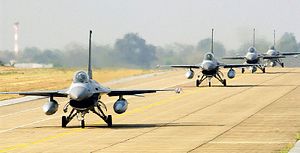On January 18, as expected, Singapore announced that after years of consideration, it had selected the F-35 as the best option for it to replace its current aging F-16 fighter jets. The decision has once again drawn attention to the city-state’s longstanding efforts to modernize its air force capabilities, even as it has left the specifics unclear about how it will proceed in the coming years.
As I have noted previously in these pages, one aspect of Singapore’s efforts to modernize and upgrade the capabilities of the Republic of Singapore Air Force (RSAF) is to find a replacement for its aging F-16 fighter jets, which face obsolescence beyond 2030.
Singapore already currently operates 60 F-16 C/D Block 52 and Advanced Block 52 aircraft, and efforts had already begun to upgrade them with Lockheed Martin. But amid various considerations, including cost, the long lead time for replacement, and the need for proper domestic messaging, the city-state has been providing periodic updates about its evaluation process about the best platforms that could serve its needs over the past few years.
Since last year, renewed indications from Singapore defense officials had suggested that a definitive decision was to be made in the months that followed. And while there was no public confirmation of this, the winner was expected to be the F-35.
Finally, last week, Singapore officially announced that it had completed its evaluation process on its F-16 fighter jet replacement. According to a statement released by the Singapore defense ministry (MINDEF) on January 18, the RSAF and the Defense Science and Technology Agency (DSTA) had completed the technical evaluation and it had identified the F-35 as the most suitable replacement.
With the decision now having been made, the focus will shift on exactly how Singapore will proceed on this front. As of now, few additional specifics have been publicly disclosed on this front. The MINDEF statement only noted that the evaluation had concluded that the RSAF should purchase only a “small number” of F-35s to fully evaluate their capabilities and suitability before deciding on a full fleet. It also added that MINDEF would discuss details with relevant parties in the United States before confirming its decision.
Still, given Singapore’s traditional alignment posture and orientation, previous choices with respect to its fighter jets, and the future shape of its priorities for modernization, it is difficult to see city-state look beyond the F-35s for its defense needs. The real question, as ever, is the exact path that it chooses to proceed and how it messages that both at home and abroad.































